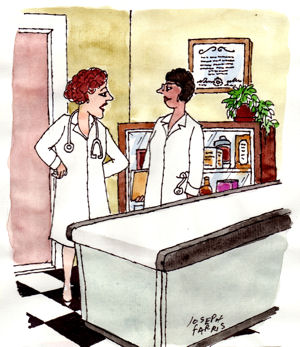Letters to the Editor
What do an X-ray machine in Oregon and a shower chair in Bellmore, N.Y. have in common? Both are available for free on a Web site that matches U.S. donors of medical equipment to needy recipients.
CCIM already in place
In response to the College's position to the American Board of Internal Medicine's recent proposal to offer a credential in comprehensive care internal medicine [ACP InternistWeekly, Feb. 5], the CCIM sounds like it would be analogous to what is done by a geriatrician (so that certification should suffice) and even by a good oncologist, if the latter does more than just wholesale chemo. It is also the same for rheumatologists and endocrinologists who truly practice general internal medicine along with their specialty. Nonetheless, in general, I do agree with the College's position.
But do have an issue with regard to other subspecialists. As a former division director of general internal medicine at a medical school, I had responsibility for the sophomore course in physical diagnosis. All the subspecialists said that they were broadly capable of practicing general internal medicine, but when push came to shove they said that they could not teach general physical diagnosis. In order to lighten the burden on the clinical general medical faculty, I set up a course in which the subspecialists taught the history and physical evaluation of their areas of expertise and had the generalists take the last few sessions to supervise complete history and physical exams. I exempt the rheumatologists and endocrinologists from my comments because, as a rule, their differential tends to encompass pretty much all of medicine and, as they do not have high income procedures, they tend to practice broadly. A good oncologist, because of the nature of the disease, can and should undertake total general care.
I feel that, almost by definition, at least these specialists practice CCIM in addition to the true generalist and the family practitioner, with some isolated exceptions for any category. Even administrators do CCIM; certainly general teaching faculty do (albeit perhaps vicariously) through the trainees and even managed-care organization physicians who oversee quality and utilization. Those who handle strictly the business end may not qualify (I speak also from MCO experience as a staff model medical director), but the lack of a CCIM certification will not be relevant to them.
Seymour Herschberg, FACP
New York, N.Y.
Taking issue with ‘Botox’
An article in The February 2008 issue of ACP Internist (“Adding cosmetic procedures lifts internists' sagging incomes”) describes how general internists are increasingly devoting their time to performance of cosmetic procedures such as botulinum toxin injections. The principal rationale appears to be “internists' sagging incomes,” although several physicians offer testimony that offering cosmetic procedures is also professionally gratifying. Indeed one internist remarks that he gets more positive feedback from his cosmetic practice than from his internal medicine practice: “No one ever thanks you for controlling their blood sugar or prescribing a cholesterol drug.”
The almost celebratory tone of the discussion is alarming. Absent from this article is any mention of the increasing shortage of primary care physicians in the United States. Indeed, the ACP itself recently remarked on the “impending collapse of primary care medicine.” The declining primary care workforce is now being eroded further as well-trained general internists divert time and energy to cosmetic procedures.
Medical students and residents who read that the practice of general internal medicine is thankless and financially precarious will surely be discouraged from pursing careers in primary care. Instead of extolling the virtues of adding cosmetic work to internal medicine practice, we must redouble our efforts to make the practice of general internal medicine a rewarding career both financially and professionally.
Allan S. Brett, FACP
Columbia, SC
After reading the article, “Adding cosmetic procedures lifts internists' sagging incomes,” [ACP Internist, February 2008], it appears that the ACP has just given up the battle for increasing reimbursements and is admitting defeat; the only way to make a good living now is to lower oneself to learning lasers and Botox in a two-day symposium. Are you kidding?
Is ACP now going to include lasers, Botox and chemical peels to internship and residency programs? Will questions on these procedures be on the next MKSAP exam?
Shame on you! ACP should be spending time dealing with Medicare and insurance companies to increase our reimbursements so we make at least as much as my car mechanic and plumber.
Stanley R. Zimmerman, ACP Member
North Brunswick, N.J.
GAO testimony in dispute
The headline and story from ACP InternistWeekly's February 19 edition, “Primary Care Benefits from IMGs, Nonphysian Providers,” is a grossly misleading review of the testimony given by the Government Accounting Office to the Senate Committee entitled “Primary Care Professionals: Recent Supply Trends, Projections, and Valuation of Services.” The headline should have said “GAO Recommends Recalibration of Payment and Greater Valuation for Primary Care.” Your flawed summation of the testimony given by the GAO is a slap in the face to the general internist membership of the ACP. Does our own organization's mouthpiece, ACP Internist, not value U.S. medical graduates going into primary care medicine? Your article seems to compare primary care by any provider as equal to care provided by a physician, when you say “primary care providers increased per capita thanks to international medical graduates and growth in physician assistants and nurse practitioners.” Are you implying this is a good thing?
The GAO testimony articulately outlines the “ongoing decline in the nation's financial support for primary care medicine” leading to the mass exodus of U.S. medical graduates from general internal medicine, family medicine, and general pediatrics. The GAO report delineates “the key benefits of primary care medicine,” all based on studies about primary care physicians that provided more efficient, less expensive care, better management of chronic illness, higher scores on performance measures and better health outcomes. These benefits were not based on “growth in primary care” in general as you wrongly stated.
The GAO testimony emphasized the lack of valuation of primary care services and concluded that, “In our view, payment system reforms that address the undervaluing of primary care should not be strictly about raising fees but rather about recalibrating the value of all services, both specialty and primary care.” It would appear to me that at last someone in the federal government is finally getting a clue to the impending collapse of primary care, and somehow one of our very own totally missed the boat. Unbelievable!
Jacqueline W. Fincher, FACP
Thomson, Ga.
Editor's note: After ACP InternistWeekly highlighted the GAO's report, ACP responded to the testimony that had been delivered in the February 26 issue of ACP InternistWeekly.
A recent report by the Government Accountability Office (GAO) understates the developing shortage of primary care physicians, the College said in a statement submitted to the Senate Committee on Health, Education, Labor and Pensions.
The College agrees with the GAO's findings that primary care medicine is essential to better quality and lower costs and that the health care system's current financing mechanisms undervalue primary care services. However, the statement notes that clarification is necessary on two issues:
Supply of primary care physicians: The GAO study states that the number of primary care physicians has increased from 80 primary care physicians per 100,000 people in 1995 to 90 per 100,000 in 2005. However, the Health Resources and Services Administration's October 2006 report, Physician Supply and Demand: Projections to 2020, projects that the estimated requirements in 2005 were 95 primary care physicians per 100,000 people. In the same report HRSA estimates that the baseline primary care physician requirements per 100,000 people will increase to 100 by 2020.
Residents training in primary care specialties: The GAO Study states that there were 40,982 residents in primary care graduate medical training programs in 2006, based on data from the National GME Census that appears annually in the Journal of the American Medical Association. This number is misleading as it represents residents in all primary care specialties without regard to where they are in the training process or whether they plan to subspecialize. For example, while 22,099 of the 40,982 primary care residents reported were internal medicine residents, it is important to consider that only a fraction of the 22,099 internal medicine residents will go on to practice primary care. In 2006, 24% of third-year internal medicine residents surveyed stated that they intended to pursue careers in general internal medicine, down from 54% in 1998. The remainder indicated that they planned on pursuing careers in an internal medicine subspecialty or hospital medicine.
Assuming that many of the 7,964 pediatric residents that were included in the 40,982 figure also will likely subspecialize, it is evident that the number of residents who choose to practice office-based primary care upon completion of training is actually far less than what the GAO study indicates, the College statement said.
For more on ACP's position, read the report, “Creating a New National Workforce for Internal Medicine.”





